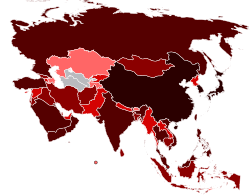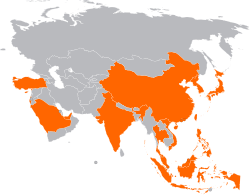-
Cases of the A(H1N1) virus in Asia:DeathsConfirmed casesSuspected casesNo reported cases
-
Number of confirmed deaths of A(H1N1) virus in Asia:No deaths1+ deaths5+ deaths10+ deaths50+ deaths100+ deaths500+ deaths1000+ deaths5000+ deaths
-
Number of confirmed cases of A(H1N1) virus in Asia:50 000+ cases5 000+ cases500+ cases50+ cases5+ cases1+ cases
-
Community Outbreaks in Asia:Community Outbreaks

Back تفشي وباء الإنفلونزا عام 2009 في قارة آسيا Arabic Pandemia de gripe A (H1N1) de 2009 en Asia Spanish Influenza A (H1N1) in Azië Dutch Pandemia de gripe A de 2009 na Ásia Portuguese Đại dịch cúm 2009 tại châu Á Vietnamese 2009年H1N1流感大流行各國疫情及反應#亞洲 Chinese
The 2009 flu pandemic in Asia, part of an epidemic in 2009 of a new strain of influenza A virus subtype H1N1 causing what has been commonly called swine flu, afflicted at least 394,133 people in Asia with 2,137 confirmed deaths: there were 1,035 deaths confirmed in India, 737 deaths in China, 415 deaths in Turkey, 192 deaths in Thailand, and 170 deaths in South Korea. Among the Asian countries, South Korea had the most confirmed cases, followed by China, Hong Kong, and Thailand.
- ^ a b c d e f g h i j k l m n o p q r s t u v w x y z aa ab ac ad ae af ag ah ai aj ak "ECDC Daily Update" (PDF). European Centre for Disease Prevention and Control. 8 January 2010. Archived from the original (PDF) on 20 February 2010. Retrieved 8 January 2010.
- ^ "Consolidated Status of Influenza A H1N1 as on 26th November 2009 (PIB 26-11-2009 )". PIB Press Release. 25 November 2009. Archived from the original on 14 February 2010. Retrieved 26 November 2009.
- ^ a b c d e f g h i j k l m n o p q r s t u v w x y z aa ab ac ad ae af ag ah ai aj ak al am an ao ap aq ar as "Swine Flu Count - Worldwide statistics of the H1N1 Influenza A Pandemic". flucount.org. 13 November 2009. Archived from the original on 2 October 2009. Retrieved 13 November 2009.
- ^ Breaking News, AFP (4 January 2010). "China records 659 flu deaths". Agence France-Presse. The Straits Times. Archived from the original on 8 January 2010. Retrieved 9 January 2010.
- ^ "Pandemic H1N1 2009 - Thailand". WHO SEARO. 14 November 2009. Archived from the original on 12 August 2009. Retrieved 25 November 2009.
- ^ "Iran has 3,672 swine flu cases: health minister". Zawya. 25 November 2009. Archived from the original on 10 August 2011. Retrieved 25 November 2009.
- ^ a b c "Pandemic (H1N1) 2009". WHO EMRO. 21 November 2009. Archived from the original on 26 November 2009. Retrieved 25 November 2009.
- ^ Daily "Swine and Seasonal Flu Monitor - Volume 1, Number 9" (PDF). Surveillance and Epidemiology Branch, Centre for Health Protection. 18 November 2009. Archived (PDF) from the original on 4 March 2021. Retrieved 19 November 2009.
- ^ "Georgia reports 120 cases of swine flu". Trend. 23 November 2009. Archived from the original on 26 November 2009. Retrieved 25 November 2009.
- ^ "H5N1: North Korea's first H1N1 case is a South Korean". Archived from the original on 4 December 2009. Retrieved 9 December 2009.



